
Neolamprologus brichardi is a species of cichlid endemic to the alkaline waters of Lake Tanganyika in East Africa. It is a popular aquarium fish kept in the fishkeeping hobby, where it is known under a variety of common names including Princess cichlid, Princess of Burundi, Lyretail cichlid, Fairy cichlid and Brichard's lamprologus. In addition, the species is also the subject of numerous studies on fish behaviour. It is closely related to N. pulcher from the southern half of Lake Tanganyika and some have recommended merging the two into a single species.

Pelvicachromis pulcher is a freshwater fish of the cichlid family, endemic to Nigeria and Cameroon. It is popular amongst aquarium hobbyists, and is most commonly sold under the name kribensis, although it has other common names, including various derivatives and color morphs of the kribensis: krib, common krib, red krib, super-red krib and rainbow krib, along with rainbow cichlid and purple cichlid.
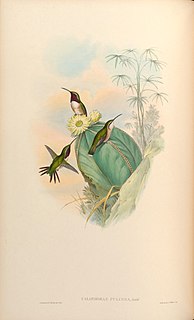
The beautiful sheartail or beautiful hummingbird is a species of hummingbird in the family Trochilidae. It is found in southern-central Mexico. Its natural habitat is subtropical or tropical high-altitude shrubland. Small hummingbird within arid bushes and shrubs in dry inland areas of southwestern Mexico. It feeds at all levels, very often on cactus flowers.
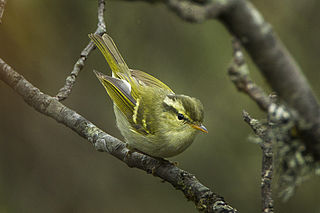
The buff-barred warbler is a species of leaf warbler. It was formerly included in the "Old World warbler" assemblage.
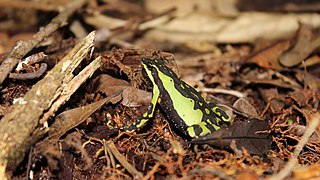
Atelopus pulcher is a species of toad in the family Bufonidae. It is endemic to eastern Peru where it is found in the Huallaga River drainage; its range might extend to Ecuador. Its natural habitats are lowland and premontane tropical forests. It is a diurnal and terrestrial species that breeds in streams.
Nyctimystes pulcher, the spurred big-eyed tree frog, is a species of frog in the family Pelodryadidae, found in New Guinea. Its natural habitats are subtropical or tropical moist lowland forests, subtropical or tropical moist montane forests, and rivers.
Barycholos pulcher is a species of frog in the family Craugastoridae. It is endemic to Pacific lowlands of Ecuador, to 600 m (2,000 ft) asl.
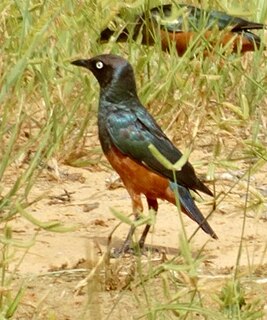
The chestnut-bellied starling is a species of starling in the family Sturnidae. This is a common resident in arid Sahelian acacia savanna, namely in Burkina Faso, Cameroon, Chad, Eritrea, Ethiopia, Gambia, Ghana, Guinea, Guinea-Bissau, Ivory Coast, Mali, Mauritania, Niger, Nigeria, Senegal, Sudan, and Togo.

The red-fronted coot is a species of bird in the family Rallidae. At 36–43 cm (14–17 in), it is a mid-sized species of coot. It is found in Argentina, southern Brazil, Chile, Paraguay, southern Peru and Uruguay. There are also records from Bolivia and the Falkland Islands. Its natural habitat is swamps and well-vegetated lakes and ponds. Fossils of this species are known from the Laguna de Tagua Tagua formation of Chile.

The plumbeous rail is a species of bird in the family Rallidae. It is found in Argentina, Bolivia, Brazil, Chile, Ecuador, Paraguay, Peru and Uruguay, and is a vagrant to the Falkland Islands. Its natural habitat is swamps. Adult plumbeous rail are distinguished by their gray and brown plumage and long colorful bill. The plumbeous rail is the only long-billed rail expected to be found in the Andean marshes with the exception of the rare Bogota rail. Fossils of this species are known from the Laguna de Tagua Tagua formation of Chile.

The black-collared apalis is a species of bird in the family Cisticolidae. It is found in the Cameroonian Highlands forests, western Kenya and the Albertine rift montane forests.

The handsome flycatcher is a species of bird in the family Tyrannidae. It is found in Bolivia, Colombia, Ecuador, and Peru. Its natural habitat is subtropical or tropical moist montane forests.
Heliodiaptomus kolleruensis is a species of copepod in the family Diaptomidae. It was described in 1981 from specimens collected in the Krishna River, Lake Kolleru and bodies of water in Guntur district, Andhra Pradesh, India. It is listed as a vulnerable species on the IUCN Red List.
Mastigodiaptomus is a genus of Neotropical copepods in the family Diaptomidae. Two of the eight species in the genus are listed as Data Deficient (DD) on the IUCN Red List, and one is listed as a vulnerable species (VU):
Muscocyclops is a genus of copepod crustaceans in the family Cyclopidae, comprising three species found only in South America. Two of the species – Muscocyclops bidentatus Reid, 1987 and Muscocyclops therasiae Reid, 1987 – are endemic to the Distrito Federal in Brazil, and are listed as conservation dependent on the IUCN Red List. The third species is Muscocyclops operculatus.

Hemigrammus pulcher is a semi-popular aquarium species, also known as the pretty tetra, garnet tetra or black wedge tetra. In the wild, the species is found near Iquitos in the Peruvian Amazon, and probably also in Brazil and Colombia.
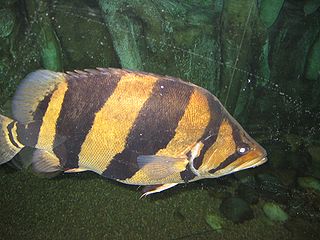
The Siamese tigerfish, also known as the Siamese tiger perch, is a critically endangered Asian fish native to the Chao Phraya, Mae Klong and Mekong basins. It has vertical yellow and black stripes running the length of its body. The dorsal fin has a spiny appearance. Siamese tigerfish grow to 40 cm (16 in) in standard length.
Synodontis pulcher is a species of upside-down catfish that is endemic to the Democratic Republic of the Congo where it is only known from Stanley Pool. It was first described by Max Poll in 1971. The original specimens were obtained from Stanley Pool, on the Congo River in what is now the Democratic Republic of the Congo. The species name pulcher means "beautiful", referring to the markings on the body.
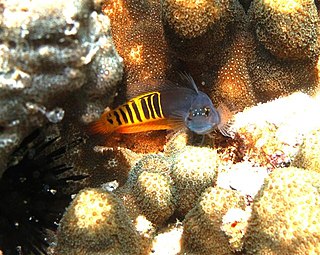
Ecsenius pulcher, the Gulf blenny, is a species of combtooth blenny in the genus Ecsenius. It is found in the western Indian Ocean. Blennies in this species feed primarily off of plants, including benthic algae and weeds.
The beautiful short-fingered gecko is a gecko species in the genus Trigonodactylus. It is found in Saudi Arabia and Yemen.













